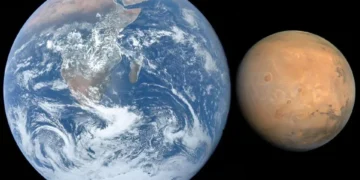Mars, often celebrated for its intriguing history and potential to harbor life, hides an enigma that perplexes planetary scientists: its small size. While Earth and Venus boast similar masses, Mars is a mere 10% of Earth’s mass. This discrepancy, dubbed the “small Mars problem,” has puzzled scientists for decades. Understanding why Mars ended up so small could answer fundamental questions about its habitability, geological history, and the processes that shaped our solar system.
The Small Mars Problem
Mars’ diminutive mass stands in stark contrast to Earth and Venus, which are similar in size and composition. Planetary scientists have long questioned why Mars didn’t grow to a comparable size. Its smaller mass has had profound consequences, from a shortened geological activity lifespan to its inability to retain a thick atmosphere. As Sean Raymond, an astrophysicist at the Bordeaux Astrophysical Laboratory, explains, “Mass is the single most fundamental property of a planet,” influencing its geological history, climate, and ability to sustain life.
Mars reached about half its current mass within the first few million years of the solar system’s formation. Despite ample material in the protoplanetary disk to form Earth- and Venus-sized planets, Mars seemingly missed out. This discrepancy lies at the heart of the small Mars problem.
Leading Theories Behind Mars’ Small Size
To solve this planetary puzzle, scientists have developed three key hypotheses:
1. The Grand Tack Model
This model proposes that Jupiter, the gas giant, migrated inward toward the Sun before “tacking” outward again. This movement disrupted the protoplanetary disk, scattering the building blocks of planets in Mars’ vicinity. According to Stephen Kane, a planetary geophysicist, “Without Jupiter’s migration, Mars might have been as large as Earth or even bigger.” Jupiter’s gravitational pull may have swept away material, leaving Mars with limited resources to grow.
2. Low-Mass Asteroid Belt Hypothesis
Another explanation suggests that Mars formed in a region of the solar system with inherently less material. This low-density environment near the asteroid belt would have constrained Mars’ ability to accumulate mass. This hypothesis aligns with observations of the sparse distribution of material in the asteroid belt today.
3. Early Instability Model
This theory argues that the early solar system was a chaotic place, with orbital instabilities scattering planetary building blocks. This turbulence could have prevented Mars from accumulating sufficient material, while Earth and Venus were in more stable zones that allowed them to grow larger.
Each of these models provides valuable insights, but none fully explains the small Mars problem on its own. Instead, it’s likely that all three factors contributed to Mars’ unique size.
Why Mars’ Small Mass Matters
Mars’ small mass has had a cascading effect on its ability to sustain geological and atmospheric processes essential for habitability. Unlike Earth, Mars’ limited mass led to a thinner atmosphere and weaker gravity, which made it vulnerable to the solar wind stripping away its gases. Stephen Kane highlights that “Mars’ small size severely limited the longevity of its geological and volcanic activity, which are crucial for atmospheric replenishment.”
This lack of geological activity also impacted Mars’ ability to maintain a magnetic field, which further exposed its atmosphere to erosion. Without a thick atmosphere, Mars struggled to retain heat, leading to its cold, arid conditions. These factors collectively contributed to the loss of surface water and the planet’s inability to sustain long-term habitability
Broader Astrobiological Insights
Mars’ small mass also has implications for the search for life beyond our solar system. Systems with multiple Earth- or Venus-sized planets might be more common than our own. Stephen Kane notes, “Our solar system’s architecture is unusual, with only about 10% of solar-type stars hosting a cold Jupiter like ours.” This rarity suggests that other systems might produce more planets in the Earth-sized range, potentially increasing the chances for habitable worlds.
By understanding why Mars is so different, scientists can better predict the types of planets that might exist in other systems and their potential for supporting life. Mars serves as a natural laboratory for testing these theories, bridging the gap between theoretical models and real-world observations.
Conclusion
Mars’ small mass is more than a planetary oddity—it’s a gateway to understanding the processes that shape planets, their atmospheres, and their potential for life. The interplay of theories like the Grand Tack model, asteroid belt dynamics, and early solar system instability highlights the complexity of planetary formation. By studying Mars, scientists can answer profound questions about our solar system’s history and the broader mechanics of planet formation across the cosmos.



















